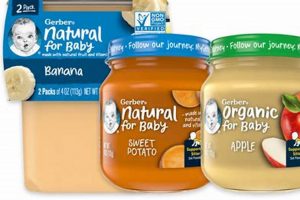A pured or mashed preparation derived from the legume Phaseolus vulgaris, specifically the black turtle bean variety, intended for consumption by infants and toddlers. It represents a nutrient-dense, easily digestible food option for introducing solid foods to developing digestive systems. An example of its usage is as an early source of plant-based protein in a baby’s diet, often introduced around 6-8 months of age.
This food source offers several key advantages for infant development. Its high fiber content supports healthy digestion, while its iron content contributes to preventing iron-deficiency anemia, a common concern in infancy. Furthermore, the presence of plant-based protein is essential for growth and development. Historically, bean-based preparations have been a staple in infant feeding practices across diverse cultures, prized for their affordability and nutritional value.
The subsequent sections will delve into the preparation methods, nutritional composition, potential allergy considerations, and appropriate storage guidelines for this type of food, providing a thorough understanding of its role in infant nutrition.
Preparation and Serving Tips
The following provides actionable guidance for safely preparing and serving this food item to infants, ensuring optimal nutritional benefit and minimizing potential risks.
Tip 1: Selection of Beans: Prioritize dried beans over canned varieties to minimize sodium content. If using canned beans, opt for low-sodium or no-salt-added options and rinse thoroughly before preparation.
Tip 2: Thorough Cooking: Cook beans until completely soft and easily mashed with a fork. Inadequate cooking can lead to digestive discomfort and reduced nutrient absorption.
Tip 3: Pureeing Consistency: Adjust the consistency according to the infant’s developmental stage. Begin with a thin puree, gradually increasing thickness as the infant’s swallowing skills improve. Use breast milk, formula, or water to achieve the desired consistency.
Tip 4: Gradual Introduction: Introduce this food in small quantities, typically one to two tablespoons, to monitor for any allergic reactions or digestive issues. Wait a few days before introducing other new foods.
Tip 5: Single-Ingredient Serving: Serve this food as a single-ingredient offering during initial introduction. This allows for easier identification of potential allergens.
Tip 6: Proper Storage: Store prepared portions in airtight containers in the refrigerator for up to 48 hours. For longer storage, freeze in individual servings for up to one month.
Tip 7: Safe Reheating: Reheat frozen or refrigerated portions thoroughly before serving. Ensure the food is heated evenly and is not too hot before offering it to the infant.
Adhering to these preparation and serving guidelines will maximize the nutritional benefits of this food for infants, while minimizing potential risks associated with introduction of solid foods.
The article will now proceed to discuss potential allergy concerns and further dietary considerations.
1. Preparation methods
The preparation methods significantly impact the safety, digestibility, and nutritional value of black bean based infant food. Adherence to specific guidelines is essential to maximize benefits and minimize potential risks associated with its introduction into an infant’s diet.
- Bean Selection and Washing
Choosing appropriate beans is the foundational step. Dried beans are generally preferred due to lower sodium content compared to canned varieties. Regardless of the form, thorough washing is crucial to remove dirt, debris, and potential contaminants. This step is essential in minimizing potential exposure to harmful substances during a baby’s feeding.
- Cooking Process Optimization
Adequate cooking is paramount. Beans must be cooked until they reach a very soft consistency, ensuring ease of digestion for an infant’s developing system. Overcooking can lead to nutrient loss, while undercooking may cause digestive upset and discomfort. Using methods such as boiling or steaming are typically employed.
- Pureeing and Texture Adjustment
The pureeing process transforms the cooked beans into a smooth, easily consumable form. The texture should be adapted to the infant’s developmental stage, starting with a very thin puree and gradually increasing the thickness as the infant matures. This process often involves the addition of liquid (breast milk, formula, or water) to achieve the desired consistency.
- Safe Storage Protocols
Proper storage techniques prevent bacterial contamination and preserve nutritional integrity. Prepared portions should be stored in airtight containers in the refrigerator and consumed within 48 hours. For extended storage, freezing in individual servings is recommended. Safe thawing and reheating practices, ensuring even heating without excessively high temperatures, are crucial.
These facets of preparation methods are intrinsically linked to the overall suitability of beans as a food for infants. Neglecting any aspect can compromise safety and nutritional value, emphasizing the importance of rigorous adherence to recommended guidelines. The subsequent discussions will explore the nutritional values and potential allergenicity.
2. Nutritional Value
The nutritional composition of this food plays a pivotal role in supporting infant growth and development. Its inherent properties contribute significantly to meeting essential dietary requirements during a crucial period of life. Understanding the specific facets of its nutritional profile is paramount for informed dietary integration.
- Protein Content and Amino Acid Profile
This food source offers a substantial amount of plant-based protein, crucial for tissue development and enzymatic functions. The amino acid profile, while not complete like animal proteins, provides essential building blocks. Complementary food pairings, such as grains, can enhance the overall amino acid availability, ensuring comprehensive protein support for infant growth.
- Fiber and Digestive Health
Dietary fiber, abundant in this food, promotes healthy bowel movements and prevents constipation, a common concern during the transition to solid foods. The fiber content contributes to the development of a healthy gut microbiome, influencing overall digestive health and nutrient absorption. However, excessive fiber intake should be monitored to avoid potential digestive discomfort.
- Iron and Mineral Bioavailability
Iron, essential for red blood cell production and cognitive development, is present. However, the non-heme iron found in plant-based sources has lower bioavailability compared to heme iron from animal sources. Pairing this food with vitamin C-rich foods can enhance iron absorption, mitigating the risk of iron deficiency anemia.
- Vitamins and Antioxidants
This food provides various vitamins, including folate, essential for cell growth and development. Antioxidants present in the beans contribute to protecting cells from oxidative stress. The specific vitamin and antioxidant content may vary depending on bean variety and preparation methods.
The integration of this nutrient-rich food into an infant’s diet, carefully considered with complementary food pairings and awareness of potential bioavailability limitations, can significantly contribute to meeting essential nutritional needs. This integration supports healthy growth, development, and overall well-being during the critical early stages of life. Future discussions will address the potential allergenicity related to this food.
3. Allergenicity Potential
The introduction of any new food into an infant’s diet necessitates careful consideration of its allergenic potential. Legumes, including the black bean, are recognized as potential allergens, albeit less commonly than other foods such as peanuts or cow’s milk. Awareness of potential allergic reactions is crucial for safe and effective integration of this food into infant feeding regimens.
- Legume Cross-Reactivity
Cross-reactivity among legumes exists, meaning an infant allergic to one type of legume may exhibit sensitivity to others. While peanut allergy is more prevalent, caution is advised when introducing black beans to infants with known allergies to other legumes, such as soybeans, peas, or lentils. A gradual introduction and close monitoring for symptoms are recommended.
- Identifying Allergic Reactions
Allergic reactions to black beans can manifest in various ways, ranging from mild skin reactions like hives or eczema to more severe symptoms such as vomiting, diarrhea, or respiratory distress. Anaphylaxis, a severe and potentially life-threatening allergic reaction, is possible, though rare. Parents and caregivers should be educated on recognizing these symptoms and seeking immediate medical attention if they occur.
- Gradual Introduction Strategies
A gradual introduction approach minimizes the risk of severe allergic reactions and facilitates the identification of potential sensitivities. Start with a small quantity, such as one to two teaspoons, and observe the infant for any signs of an allergic reaction over the subsequent 24 to 48 hours. Avoid introducing other new foods simultaneously to aid in pinpointing the source of any adverse reactions.
- Delayed Onset Reactions
Some allergic reactions to foods, including black beans, may exhibit a delayed onset, appearing several hours or even a day after ingestion. These delayed reactions can be challenging to identify and may manifest as gastrointestinal symptoms like reflux or colic. Maintaining a food diary and consulting with a pediatrician or allergist can assist in diagnosing delayed food sensitivities.
Consideration of allergenicity, alongside careful preparation and monitoring, enables a safe and informed introduction of black beans into an infant’s diet. While allergic reactions are possible, proactive strategies and awareness can mitigate the risks, allowing infants to benefit from the nutritional advantages this food offers.
4. Developmental Appropriateness
Developmental appropriateness represents a crucial consideration when integrating any solid food, including bean-based preparations, into an infant’s diet. This concept encompasses the alignment of food texture, nutritional composition, and digestive capabilities with the infant’s evolving physiological and cognitive abilities. Improper alignment can result in digestive distress, nutrient malabsorption, or even aversion to new foods.
- Texture Progression and Oral Motor Skills
Infants progress through distinct stages of oral motor development, starting with reflexive sucking and gradually developing the ability to manage thicker consistencies and textures. Initially, a smooth, pureed form of this food is appropriate. As the infant develops, the texture can be gradually increased, introducing mashed or slightly chunky versions. Premature introduction of overly textured food can lead to choking or food refusal, hindering the development of essential chewing and swallowing skills.
- Digestive System Maturity and Tolerance
The infant digestive system undergoes maturation throughout the first year of life. Enzyme production and gut microbiome composition evolve, influencing the ability to digest and absorb nutrients effectively. The relatively high fiber content of this food requires a digestive system capable of processing complex carbohydrates. Introducing this food too early, before the digestive system is adequately prepared, can result in gas, bloating, or diarrhea.
- Nutrient Density and Caloric Needs
Infants have specific caloric and nutrient requirements to support rapid growth and development. While this food offers valuable nutrients like protein and iron, it should be incorporated as part of a balanced diet that provides a variety of essential nutrients. Over-reliance on this single food source can lead to nutrient imbalances, potentially compromising optimal growth and development. Portion sizes should be adjusted based on the infant’s age, weight, and overall dietary intake.
- Allergen Introduction Timing
Current pediatric guidelines recommend introducing potentially allergenic foods, including legumes, early in infancy, typically between 4 and 6 months of age, to reduce the risk of developing food allergies. However, this introduction should occur under the supervision of a healthcare professional, particularly for infants with a family history of allergies. The timing of introduction should be tailored to the individual infant’s risk factors and developmental readiness.
These facets of developmental appropriateness underscore the importance of a tailored approach to introducing this food. Consideration of the infant’s oral motor skills, digestive maturity, nutrient needs, and allergenic risk factors is paramount. A gradual and responsive approach, guided by healthcare professional recommendations, ensures the safe and effective integration of this food, promoting optimal infant health and development.
5. Storage Guidelines
Storage guidelines represent a critical component of ensuring the safety and nutritional integrity of this food intended for infant consumption. Improper storage practices can lead to bacterial contamination, nutrient degradation, and ultimately, health risks for the infant. The direct correlation between adherence to recommended storage protocols and the maintenance of a safe and nutritious food source is paramount. For example, leaving prepared portions at room temperature for extended periods fosters bacterial growth, increasing the risk of foodborne illness.
Specific storage recommendations dictate that prepared portions be stored in airtight containers in the refrigerator and consumed within 48 hours. This timeframe minimizes the potential for bacterial proliferation while preserving the food’s nutritional value. For extended storage, freezing in individual servings is advisable, allowing for preservation for up to one month. Thawing and reheating should be conducted safely, ensuring even heating to kill any potential pathogens without compromising the food’s consistency or nutritional content. A failure to heed these guidelines can negate the inherent benefits of black beans as a nutritious food option for infants, rendering the product potentially harmful.
In summary, meticulous adherence to storage guidelines is inextricably linked to the safety and nutritional efficacy of prepared black beans for infant feeding. The consequences of neglecting these protocols range from diminished nutritional value to potential health risks. Understanding and implementing proper storage practices is not merely a suggestion, but a necessity for safeguarding infant well-being and maximizing the benefits of this food source.
6. Serving Suggestions
Appropriate serving suggestions are integral to the successful incorporation of black bean baby food into an infant’s dietary regimen. Considerations extend beyond mere presentation, encompassing portion control, complementary food pairings, and techniques to enhance acceptance and maximize nutritional benefit.
- Age-Appropriate Portion Sizes
Portion sizes must align with the infant’s developmental stage and caloric needs. Initially, a small serving, typically one to two tablespoons, suffices. As the infant grows, portion sizes can be gradually increased. Overfeeding can lead to digestive discomfort, while insufficient portions may not adequately address nutritional requirements. Observing the infant’s cues for satiety is crucial in determining appropriate serving amounts.
- Complementary Food Pairings
Pairing this food with complementary food sources enhances nutrient bioavailability and provides a more balanced nutritional profile. For example, serving with a source of vitamin C, such as pureed sweet peppers, increases the absorption of non-heme iron. Combining with grains, such as rice cereal, provides a more complete amino acid profile. Strategically combining different food groups enhances the overall nutritional value of the meal.
- Strategies for Enhancing Palatability
Infants may initially exhibit reluctance towards new flavors and textures. Strategies to enhance palatability include mixing with familiar flavors, such as breast milk or formula. Introducing small amounts alongside preferred foods can also increase acceptance. Gradual exposure to this food, presented in a positive and encouraging manner, is more likely to foster acceptance than forceful feeding.
- Monitoring for Acceptance and Tolerance
Close monitoring of the infant’s reaction to this food is essential. Signs of intolerance or allergic reaction, such as skin rash, digestive upset, or respiratory distress, warrant immediate attention. Observing the infant’s acceptance of the flavor and texture provides valuable feedback for future serving strategies. Individual infants may exhibit varying preferences and tolerances, necessitating a tailored approach to feeding.
Serving suggestions are not merely ancillary details, but rather essential components of successful integration of this food. Careful consideration of portion sizes, complementary food pairings, palatability enhancement, and vigilant monitoring of the infant’s response contributes to maximizing the nutritional benefits and fostering a positive feeding experience. These nuanced strategies enhance the value of this food as a component of infant nutrition.
Frequently Asked Questions
The following addresses common inquiries regarding the utilization of black beans as a nutritional source for infants, providing evidence-based guidance for safe and effective integration into their diets.
Question 1: At what age can black bean baby food be safely introduced?
Current pediatric guidelines generally recommend introducing solid foods, including pureed legumes like black beans, between 4 and 6 months of age. However, it is crucial to consult with a pediatrician to assess individual readiness based on developmental milestones and potential allergy concerns.
Question 2: Are canned black beans a suitable option for infant food preparation?
While canned black beans can be used, preference should be given to dried beans due to their lower sodium content. If using canned beans, opt for low-sodium or no-salt-added varieties and rinse thoroughly to minimize sodium intake.
Question 3: How should potential allergic reactions to black beans be monitored?
Introduce black beans in small quantities initially, such as one to two teaspoons. Observe the infant for any signs of an allergic reaction, including skin rashes, hives, vomiting, diarrhea, or respiratory distress. Seek immediate medical attention if any of these symptoms occur.
Question 4: How can iron absorption from black bean baby food be maximized?
Black beans contain non-heme iron, which is less readily absorbed than heme iron from animal sources. Pairing this food with a source of vitamin C, such as pureed fruits or vegetables, enhances iron absorption.
Question 5: What consistency should black bean baby food be?
Initially, the consistency should be a smooth puree, free from lumps or chunks. As the infant’s oral motor skills develop, the texture can be gradually increased, introducing mashed or slightly thicker versions.
Question 6: How long can black bean baby food be safely stored?
Prepared black bean baby food can be stored in the refrigerator for up to 48 hours. For longer storage, freeze in individual servings for up to one month. Thaw and reheat thoroughly before serving, ensuring the food is evenly heated and not excessively hot.
In conclusion, the integration of black beans into an infant’s diet necessitates adherence to established guidelines regarding age-appropriateness, preparation methods, and allergen monitoring. Proper implementation maximizes nutritional benefits and minimizes potential risks.
The subsequent section will address potential issues and solutions in integrating this food item to an infant’s diet.
Conclusion
This exploration has provided a comprehensive overview of “black bean baby food,” encompassing preparation methods, nutritional value, potential allergenicity, developmental appropriateness, storage guidelines, and serving suggestions. These facets are essential for the safe and effective integration of this food source into an infant’s diet. Considerations such as proper cooking, texture adjustment, allergen monitoring, and age-appropriate portioning are paramount for optimizing infant health and well-being.
The judicious inclusion of this food, guided by pediatric recommendations and careful observation of the infant’s response, represents a viable strategy for diversifying an infant’s nutritional intake and fostering healthy dietary habits from an early age. Continued research and informed parental practices remain crucial for maximizing the benefits and mitigating potential risks associated with its usage.







